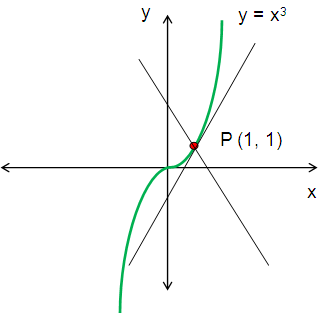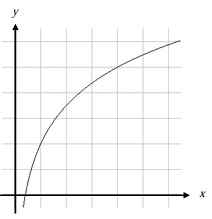EQUATION OF NORMAL TO THE CURVE WITH DERIVATIVE

Step 1 :
By finding the first derivative, we get slope of the tangent line drawn to the curve.
Step 2 :
By applying the specific point in the general slope, we can find slope of the tangent line drawn at the specific point.
Step 3 :
From slope of tangent we have to find the slope of normal (-1/m).
Step 4 :
Now we have to apply the point and the slope in the formula
(y - y1) = (-1/m) (x - x1)
Example 1 :
Find the equation of the tangent to the curve
y = x3
at the point (1, 1)

Solution :
y = x3
Step 1 :
dy/dx = 3x2
slope of the curve at the point (1, 1)
dy/dx = 3(1)2
Slope at (1, 1) :
dy/dx = 3
Slope of normal = -1/3
Equation of the normal :
(y - y1) = (-1/m) (x - x1)
(y-1) = (-1/3) (x - 1)
3(y - 1) = -1(x - 1)
3y-3 = -x + 1
x + 3y - 3 - 1 = 0
x + 3y - 4 = 0
The required equation of normal is x+3y-4 = 0.
Example 2 :
Find the equation of normal to the curve
y = x2-x-2
at the point (1, -2)
Solution :
y = x2-x-2
dy/dx = 2x-1
Slope at the point (1, -2) :
dy/dx = 2(1) - 1
= 2-1
dy/dx = 1
slope of the tangent (dy/dx) = 1
Slope of normal = -1/1
= -1
Equation of the normal :
(y - y1) = (-1/m) (x - x1)
(y-(-2)) = -1 (x-1)
y+2 = -x+1
x+y+2-1 = 0
x+y+1 = 0
Equation of normal is x+y+1 = 0.
Example 3 :
Find a point on the curve y = √x, where the tangent makes an angle of 45 degrees with the positive x-axis.
Solution :
y = √x
m = tan θ
m = tan 45
m = 1 ---(1)
dy/dx = 1/2√x ---(2)
(1) = (2)
1 = 1/2√x
2√x = 1
4x = 1
x = 1/4
By applying the value of x in y = √x, we get
y = √(1/4)
y = ± 1/2
Since the tangent drawn at the positive x-axis, we find equation of the tangent at the point (1/4, 1/2).
Equation of the tangent line :
y - y1 = m(x - x1)
y - (1/2) = 1(x - 1/4)
(2y - 1)/2 = 1(4x - 1)/4
4(2y - 1) = 2(4x - 1)
8y - 4 = 8x - 2
8x - 8y - 2 + 4 = 0
8x - 8y + 2 = 0
4x - 4y + 1 = 0
So, equation of tangent is 4x - 4y + 1 = 0.
Example 4 :
Find a points on the curve y = 2x3 + 3x2 - 12x + 1 where the tangent is horizontal ?
Solution :
y = 2x3 + 3x2 - 12x + 1
When the tangent is horizontal, it's slope = 0
dy/dx = 2(3x2) + 3(2x) - 12(1) + 0
dy/dx = 6x2 + 6x - 12
dy/dx = 0
6x2 + 6x - 12 = 0
Dividing by 6, we get
x2 + x - 2 = 0
(x + 2) (x - 1) = 0
Equating each factor to 0, we get
x = -2 and x = 1
At x = -2 and x = 1, the tangent will be horizontal.
Example 5 :
If f(2) = 3 and f'(2) = 5, find the equation of the tangent line to f(x) at x = 2.
Solution :
f(2) = 3 and f'(2) = 5
The curve is passing through the point (2, 3). Slope at x = 2 is 5.
Equation of tangent :
y - y1 = m(x - x1)
y - 3 = 5(x - 2)
y = 5x - 10 + 3
y = 5x - 7
Example 6 :
Use the figure to the below to answer the following questions:

a) What is f (1) and f (4) ?
b) What is the geometric interpretation of
[f(4) - f(1)]/(4 - 1) ?
c) Using the geometric interpretation of each expression, insert the proper inequality symbol (< or >)
i) [f(4) - f(1)]/(4 - 1) ______ [f(4) - f(3)]/(4 - 3)
ii) [f(4) - f(1)]/(4 - 1) ____ f'(1)
Solution :

a) From the figure above
f(1) = 2 and f(4) = 5
b) [f(4) - f(1)]/(4 - 1)
Applying the values above,
= (5 - 2)/3
= 3/3
= 1
[f(4) - f(1)]/(4 - 1) = 1
c)
i) [f(4) - f(1)]/(4 - 1) = 1 (From above calculation)
f(3) = 4.5 (from the above figure)
[f(4) - f(3)]/(4 - 3) = (5 - 4.5)/1
= 0.5
Comparing the slopes, 1 > 0.5
ii) [f(4) - f(1)]/(4 - 1) ____ f'(1)
[f(4) - f(1)]/(4 - 1) = 1
[f(4) - f(1)]/(4 - 1) > f'(1)
Example 7 :
Use the graph of f (x) shown below.

a) Where is f'(x) = 0 ?, explain.
b) Where is f'(x) > 0 ?, explain.
c) Where is f'(x) < 0 ?, explain.
Solution :
a) From the graph above, at x = -1 and at x = 3, we draw the horizontal tangent line. Then at x = -1 and x = 3, the slope is 0.
b) At (-∞, -1) and (3, ∞) the curve is increasing. At these intervals, the curve will have positive slope.
At (-1, 3), the curve is decreasing. So, at (-1, 3) the curve will have negative slope.
Kindly mail your feedback to v4formath@gmail.com
We always appreciate your feedback.
©All rights reserved. onlinemath4all.com
Recent Articles
-
Digital SAT Math Problems and Solutions (Part - 152)
Apr 28, 25 11:54 AM
Digital SAT Math Problems and Solutions (Part - 152) -
Digital SAT Math Problems and Solutions (Part - 151)
Apr 26, 25 11:18 AM
Digital SAT Math Problems and Solutions (Part - 151) -
AP Calculus BC Problems with Solutions
Apr 26, 25 05:49 AM
AP Calculus BC Problems with Solutions
